International Space Stastion(ISS)
International Space Station
 Oblique forward view in November 2021. | |
  International Space Station program insignia. | |
| Station statistics | |
|---|---|
| COSPAR ID | 1998-067A |
| SATCAT no. | 25544 |
| Call sign | Alpha, Station |
| Crew | Fully crewed: 7 Currently aboard: 10 (Soyuz MS-21, Crew-4, Soyuz MS-22) Expedition: 68 Commander: Samantha Cristoforetti (ESA,ASI) |
| Launch | 20 November 1998 |
| Launch pad |
|
| Mass | 444,615 kg (980,208 lb)[1] |
| Length | 73.0 m (239.4 ft)[1] |
| Width | 109.0 m (357.5 ft)[1] |
| Pressurised volume | 915.6 m3 (32,333 cu ft)[1] |
| Atmospheric pressure | 101.3 kPa (14.7 psi; 1.0 atm) 79% nitrogen, 21% oxygen |
| Perigee altitude | 413 km (256.6 mi) AMSL[2] |
| Apogee altitude | 422 km (262.2 mi) AMSL[2] |
| Orbital inclination | 51.64°[2] |
| Orbital speed | 7.66 km/s[2][failed verification] (27,600 km/h; 17,100 mph) |
| Orbital period | 92.68 minutes[2][failed verification] |
| Orbits per day | 15.49[2] |
| Orbit epoch | 24 April 2022 16:30:11 [2] |
| Days in orbit | 23 years, 10 months, 8 days (29 September 2022) |
| Days occupied | 21 years, 10 months, 26 days (29 September 2022) |
| No. of orbits | 133,312 as of June 2022[3] |
| Orbital decay | 2 km/month |
| Statistics as of 9 March 2011 (unless noted otherwise) References: [1][2][4][5][6] | |
| Configuration | |
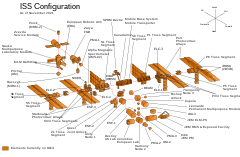 Station elements as of November 2021 (exploded view) | |
The International Space Station (ISS) is the largest modular space station currently in low Earth orbit. It is a multinational collaborative project involving five participating space agencies: NASA (United States), Roscosmos (Russia), JAXA (Japan), ESA (Europe), and CSA (Canada).[7][8] The ownership and use of the space station is established by intergovernmental treaties and agreements.[9] The station serves as a microgravity and space environment research laboratory in which scientific research is conducted in astrobiology, astronomy, meteorology, physics, and other fields.[10][11][12] The ISS is suited for testing the spacecraft systems and equipment required for possible future long-duration missions to the Moon and Mars.[13]
The ISS programme evolved from the Space Station Freedom, a 1984 American proposal to construct a permanently crewed Earth-orbiting station,[14] and the contemporaneous Soviet/Russian Mir-2 proposal from 1976 with similar aims. The ISS is the ninth space station to be inhabited by crews, following the Soviet and later Russian Salyut, Almaz, and Mir stations and the American Skylab. It is the largest artificial object in space and the largest satellite in low Earth orbit, regularly visible to the naked eye from Earth's surface.[15][16] It maintains an orbit with an average altitude of 400 kilometres (250 mi) by means of reboost manoeuvres using the engines of the Zvezda Service Module or visiting spacecraft.[17] The ISS circles the Earth in roughly 93 minutes, completing 15.5 orbits per day.[18]
The station is divided into two sections: the Russian Orbital Segment (ROS) is operated by Russia, while the United States Orbital Segment (USOS) is run by the United States as well as by the other states. The Russian segment includes six modules. The US segment includes ten modules, whose support services are distributed 76.6% for NASA, 12.8% for JAXA, 8.3% for ESA and 2.3% for CSA.
Roscosmos had previously[19][20] endorsed the continued operation of ROS through 2024,[21] having proposed using elements of the segment to construct a new Russian space station called OPSEK.[22] However, continued cooperation has been rendered uncertain by the 2022 Russian invasion of Ukraine and subsequent international sanctions on Russia, who theoretically, may lower, redirect, or cut funding from their side of the space station due to the sanctions set on them.[19][20]
The first ISS component was launched in 1998, and the first long-term residents arrived on 2 November 2000 after being launched from the Baikonur Cosmodrome on 31 October 2000.[23] The station has since been continuously occupied for 21 years and 331 days,[24] the longest continuous human presence in low Earth orbit, having surpassed the previous record of 9 years and 357 days held by the Mir space station. The latest major pressurised module, Nauka, was fitted in 2021, a little over ten years after the previous major addition, Leonardo in 2011. Development and assembly of the station continues, with an experimental inflatable space habitat added in 2016, and several major new Russian elements scheduled for launch starting in 2021. In January 2022, the station's operation authorization was extended to 2030, with funding secured within the United States through that year.[25][26] There have been calls to privatize ISS operations after that point to pursue future Moon and Mars missions, with former NASA Administrator Jim Bridenstine stating: "given our current budget constraints, if we want to go to the moon and we want to go to Mars, we need to commercialize low Earth orbit and go on to the next step."[27]
The ISS consists of pressurised habitation modules, structural trusses, photovoltaic solar arrays, thermal radiators, docking ports, experiment bays and robotic arms. Major ISS modules have been launched by Russian Proton and Soyuz rockets and US Space Shuttles.[28] The station is serviced by a variety of visiting spacecraft: the Russian Soyuz and Progress, the SpaceX Dragon 2, and the Northrop Grumman Space Systems Cygnus,[29] and formerly the European Automated Transfer Vehicle (ATV), the Japanese H-II Transfer Vehicle,[7] and SpaceX Dragon 1. The Dragon spacecraft allows the return of pressurised cargo to Earth, which is used, for example, to repatriate scientific experiments for further analysis. As of April 2022, 251 astronauts, cosmonauts, and space tourists from 20 different nations have visited the space station, many of them multiple times.
History[edit]
In the early 1980s, NASA planned to launch a modular space station called Freedom as a counterpart to the Soviet Salyut and Mir space stations. In 1984 the ESA was invited to participate in Space Station Freedom, and the ESA approved the Columbus laboratory by 1987.[30] The Japanese Experiment Module (JEM), or Kibō, was announced in 1985, as part of the Freedom space station in response to a NASA request in 1982.
In early 1985, science ministers from the European Space Agency (ESA) countries approved the Columbus programme, the most ambitious effort in space undertaken by that organisation at the time. The plan spearheaded by Germany and Italy included a module which would be attached to Freedom, and with the capability to evolve into a full-fledged European orbital outpost before the end of the century. The space station was also going to tie the emerging European and Japanese national space programmes closer to the US-led project, thereby preventing those nations from becoming major, independent competitors too.[31]
In September 1993, American Vice-President Al Gore and Russian Prime Minister Viktor Chernomyrdin announced plans for a new space station, which eventually became the International Space Station.[32] They also agreed, in preparation for this new project, that the United States would be involved in the Mir programme, including American Shuttles docking, in the Shuttle–Mir programme.[33]
On 12 April 2021, at a meeting with Russian President Vladimir Putin, then-Deputy Prime Minister Yury Borisov announced he had decided that Russia might withdraw from the ISS programme in 2025.[34][35] According to Russian authorities, the timeframe of the station’s operations has expired and its condition leaves much to be desired.[34] On 26 July 2022, Borisov, who had become head of Roscosmos, submitted to Putin his plans for withdrawal from the programme after 2024.[36] However, Robyn Gatens, the NASA official in charge of space station operations, responded that NASA had not received any formal notices from Roscosmos concerning withdrawal plans.[37]Purpose[edit]
The ISS was originally intended to be a laboratory, observatory, and factory while providing transportation, maintenance, and a low Earth orbit staging base for possible future missions to the Moon, Mars, and asteroids. However, not all of the uses envisioned in the initial memorandum of understanding between NASA and Roscosmos have been realised.[38] In the 2010 United States National Space Policy, the ISS was given additional roles of serving commercial, diplomatic,[39] and educational purposes.[40]
Scientific research[edit]
The ISS provides a platform to conduct scientific research, with power, data, cooling, and crew available to support experiments. Small uncrewed spacecraft can also provide platforms for experiments, especially those involving zero gravity and exposure to space, but space stations offer a long-term environment where studies can be performed potentially for decades, combined with ready access by human researchers.[41][42]
The ISS simplifies individual experiments by allowing groups of experiments to share the same launches and crew time. Research is conducted in a wide variety of fields, including astrobiology, astronomy, physical sciences, materials science, space weather, meteorology, and human research including space medicine and the life sciences.[10][11][12][43][44] Scientists on Earth have timely access to the data and can suggest experimental modifications to the crew. If follow-on experiments are necessary, the routinely scheduled launches of resupply craft allows new hardware to be launched with relative ease.[42] Crews fly expeditions of several months' duration, providing approximately 160 person-hours per week of labour with a crew of six. However, a considerable amount of crew time is taken up by station maintenance.[10][45]
Perhaps the most notable ISS experiment is the Alpha Magnetic Spectrometer (AMS), which is intended to detect dark matter and answer other fundamental questions about our universe. According to NASA, the AMS is as important as the Hubble Space Telescope. Currently docked on station, it could not have been easily accommodated on a free flying satellite platform because of its power and bandwidth needs.[46][47] On 3 April 2013, scientists reported that hints of dark matter may have been detected by the AMS.[48][49][50][51][52][53] According to the scientists, "The first results from the space-borne Alpha Magnetic Spectrometer confirm an unexplained excess of high-energy positrons in Earth-bound cosmic rays".
The space environment is hostile to life. Unprotected presence in space is characterised by an intense radiation field (consisting primarily of protons and other subatomic charged particles from the solar wind, in addition to cosmic rays), high vacuum, extreme temperatures, and microgravity.[54] Some simple forms of life called extremophiles,[55] as well as small invertebrates called tardigrades[56] can survive in this environment in an extremely dry state through desiccation.
Medical research improves knowledge about the effects of long-term space exposure on the human body, including muscle atrophy, bone loss, and fluid shift. These data will be used to determine whether high duration human spaceflight and space colonisation are feasible. In 2006, data on bone loss and muscular atrophy suggested that there would be a significant risk of fractures and movement problems if astronauts landed on a planet after a lengthy interplanetary cruise, such as the six-month interval required to travel to Mars.[57][58]
Medical studies are conducted aboard the ISS on behalf of the National Space Biomedical Research Institute (NSBRI). Prominent among these is the Advanced Diagnostic Ultrasound in Microgravity study in which astronauts perform ultrasound scans under the guidance of remote experts. The study considers the diagnosis and treatment of medical conditions in space. Usually, there is no physician on board the ISS and diagnosis of medical conditions is a challenge. It is anticipated that remotely guided ultrasound scans will have application on Earth in emergency and rural care situations where access to a trained physician is difficult.[59][60][61]
In August 2020, scientists reported that bacteria from Earth, particularly Deinococcus radiodurans bacteria, which is highly resistant to environmental hazards, were found to survive for three years in outer space, based on studies conducted on the International Space Station. These findings supported the notion of panspermia, the hypothesis that life exists throughout the Universe, distributed in various ways, including space dust, meteoroids, asteroids, comets, planetoids or contaminated spacecraft.[62][63]
Remote sensing of the Earth, astronomy, and deep space research on the ISS have dramatically increased during the 2010s after the completion of the US Orbital Segment in 2011. Throughout the more than 20 years of the ISS program researchers aboard the ISS and on the ground have examined aerosols, ozone, lightning, and oxides in Earth's atmosphere, as well as the Sun, cosmic rays, cosmic dust, antimatter, and dark matter in the universe. Examples of Earth-viewing remote sensing experiments that have flown on the ISS are the Orbiting Carbon Observatory 3, ISS-RapidScat, ECOSTRESS, the Global Ecosystem Dynamics Investigation, and the Cloud Aerosol Transport System. ISS-based astronomy telescopes and experiments include SOLAR, the Neutron Star Interior Composition Explorer, the Calorimetric Electron Telescope, the Monitor of All-sky X-ray Image (MAXI), and the Alpha Magnetic Spectrometer.[11][64]
Freefall[edit]
Gravity at the altitude of the ISS is approximately 90% as strong as at Earth's surface, but objects in orbit are in a continuous state of freefall, resulting in an apparent state of weightlessness.[65] This perceived weightlessness is disturbed by five effects:[66]
- Drag from the residual atmosphere.
- Vibration from the movements of mechanical systems and the crew.
- Actuation of the on-board attitude control moment gyroscopes.
- Thruster firings for attitude or orbital changes.
- Gravity-gradient effects, also known as tidal effects. Items at different locations within the ISS would, if not attached to the station, follow slightly different orbits. Being mechanically connected these items experience small forces that keep the station moving as a rigid body.
Researchers are investigating the effect of the station's near-weightless environment on the evolution, development, growth and internal processes of plants and animals. In response to some of the data, NASA wants to investigate microgravity's effects on the growth of three-dimensional, human-like tissues and the unusual protein crystals that can be formed in space.[11]
Investigating the physics of fluids in microgravity will provide better models of the behaviour of fluids. Because fluids can be almost completely combined in microgravity, physicists investigate fluids that do not mix well on Earth. Examining reactions that are slowed by low gravity and low temperatures will improve our understanding of superconductivity.[11]
The study of materials science is an important ISS research activity, with the objective of reaping economic benefits through the improvement of techniques used on the ground.[67] Other areas of interest include the effect of low gravity on combustion, through the study of the efficiency of burning and control of emissions and pollutants. These findings may improve knowledge about energy production and lead to economic and environmental benefits.[11]
Exploration[edit]
The ISS provides a location in the relative safety of low Earth orbit to test spacecraft systems that will be required for long-duration missions to the Moon and Mars. This provides experience in operations, maintenance as well as repair and replacement activities on-orbit. This will help develop essential skills in operating spacecraft farther from Earth, reduce mission risks, and advance the capabilities of interplanetary spacecraft.[13] Referring to the MARS-500 experiment, a crew isolation experiment conducted on Earth, ESA states that "Whereas the ISS is essential for answering questions concerning the possible impact of weightlessness, radiation and other space-specific factors, aspects such as the effect of long-term isolation and confinement can be more appropriately addressed via ground-based simulations".[68] Sergey Krasnov, the head of human space flight programmes for Russia's space agency, Roscosmos, in 2011 suggested a "shorter version" of MARS-500 may be carried out on the ISS.[69]
In 2009, noting the value of the partnership framework itself, Sergey Krasnov wrote, "When compared with partners acting separately, partners developing complementary abilities and resources could give us much more assurance of the success and safety of space exploration. The ISS is helping further advance near-Earth space exploration and realisation of prospective programmes of research and exploration of the Solar system, including the Moon and Mars."[70] A crewed mission to Mars may be a multinational effort involving space agencies and countries outside the current ISS partnership. In 2010, ESA Director-General Jean-Jacques Dordain stated his agency was ready to propose to the other four partners that China, India and South Korea be invited to join the ISS partnership.[71] NASA chief Charles Bolden stated in February 2011, "Any mission to Mars is likely to be a global effort".[72] Currently, US federal legislation prevents NASA co-operation with China on space projects.[73]
Education and cultural outreach[edit]
The ISS crew provides opportunities for students on Earth by running student-developed experiments, making educational demonstrations, allowing for student participation in classroom versions of ISS experiments, and directly engaging students using radio, and email.[7][74] ESA offers a wide range of free teaching materials that can be downloaded for use in classrooms.[75] In one lesson, students can navigate a 3D model of the interior and exterior of the ISS, and face spontaneous challenges to solve in real time.[76]
The Japanese Aerospace Exploration Agency (JAXA) aims to inspire children to "pursue craftsmanship" and to heighten their "awareness of the importance of life and their responsibilities in society".[77] Through a series of education guides, students develop a deeper understanding of the past and near-term future of crewed space flight, as well as that of Earth and life.[78][79] In the JAXA "Seeds in Space" experiments, the mutation effects of spaceflight on plant seeds aboard the ISS are explored by growing sunflower seeds that have flown on the ISS for about nine months. In the first phase of Kibō utilisation from 2008 to mid-2010, researchers from more than a dozen Japanese universities conducted experiments in diverse fields.[80]
Cultural activities are another major objective of the ISS programme. Tetsuo Tanaka, the director of JAXA's Space Environment and Utilization Center, has said: "There is something about space that touches even people who are not interested in science."[81]
Amateur Radio on the ISS (ARISS) is a volunteer programme that encourages students worldwide to pursue careers in science, technology, engineering, and mathematics, through amateur radio communications opportunities with the ISS crew. ARISS is an international working group, consisting of delegations from nine countries including several in Europe, as well as Japan, Russia, Canada, and the United States. In areas where radio equipment cannot be used, speakerphones connect students to ground stations which then connect the calls to the space station.[82]
First Orbit is a 2011 feature-length documentary film about Vostok 1, the first crewed space flight around the Earth. By matching the orbit of the ISS to that of Vostok 1 as closely as possible, in terms of ground path and time of day, documentary filmmaker Christopher Riley and ESA astronaut Paolo Nespoli were able to film the view that Yuri Gagarin saw on his pioneering orbital space flight. This new footage was cut together with the original Vostok 1 mission audio recordings sourced from the Russian State Archive. Nespoli is credited as the director of photography for this documentary film, as he recorded the majority of the footage himself during Expedition 26/27.[83] The film was streamed in a global YouTube premiere in 2011 under a free licence through the website firstorbit.org.[84]
In May 2013, commander Chris Hadfield shot a music video of David Bowie's "Space Oddity" on board the station, which was released on YouTube.[85][86] It was the first music video ever to be filmed in space.[87]
In November 2017, while participating in Expedition 52/53 on the ISS, Paolo Nespoli made two recordings of his spoken voice (one in English and the other in his native Italian), for use on Wikipedia articles. These were the first content made in space specifically for Wikipedia.[88][89]
In November 2021, a virtual reality exhibit called The Infinite featuring life aboard the ISS was announced.[90]
Construction[edit]
Manufacturing[edit]
Since the International Space Station is a multi-national collaborative project, the components for in-orbit assembly were manufactured in various countries around the world. Beginning in the mid-1990s, the U.S. components Destiny, Unity, the Integrated Truss Structure, and the solar arrays were fabricated at the Marshall Space Flight Center and the Michoud Assembly Facility. These modules were delivered to the Operations and Checkout Building and the Space Station Processing Facility (SSPF) for final assembly and processing for launch.[91]
The Russian modules, including Zarya and Zvezda, were manufactured at the Khrunichev State Research and Production Space Center in Moscow. Zvezda was initially manufactured in 1985 as a component for Mir-2, but was never launched and instead became the ISS Service Module.[92]
The European Space Agency (ESA) Columbus module was manufactured at the EADS Astrium Space Transportation facilities in Bremen, Germany, along with many other contractors throughout Europe.[93] The other ESA-built modules – Harmony, Tranquility, the Leonardo MPLM, and the Cupola – were initially manufactured at the Thales Alenia Space factory in Turin, Italy.[94] The structural steel hulls of the modules were transported by aircraft to the Kennedy Space Center SSPF for launch processing.[95]
The Japanese Experiment Module Kibō, was fabricated in various technology manufacturing facilities in Japan, at the NASDA (now JAXA) Tsukuba Space Center, and the Institute of Space and Astronautical Science. The Kibo module was transported by ship and flown by aircraft to the SSPF.[96]
The Mobile Servicing System, consisting of the Canadarm2 and the Dextre grapple fixture, was manufactured at various factories in Canada (such as the David Florida Laboratory) and the United States, under contract by the Canadian Space Agency. The mobile base system, a connecting framework for Canadarm2 mounted on rails, was built by Northrop Grumman.
Assembly[edit]
The assembly of the International Space Station, a major endeavour in space architecture, began in November 1998.[4] Russian modules launched and docked robotically, with the exception of Rassvet. All other modules were delivered by the Space Shuttle, which required installation by ISS and Shuttle crewmembers using the Canadarm2 (SSRMS) and extra-vehicular activities (EVAs); by 5 June 2011, they had added 159 components during more than 1,000 hours of EVA. 127 of these spacewalks originated from the station, and the remaining 32 were launched from the airlocks of docked Space Shuttles.[97] The beta angle of the station had to be considered at all times during construction.[98]
The first module of the ISS, Zarya, was launched on 20 November 1998 on an autonomous Russian Proton rocket. It provided propulsion, attitude control, communications, and electrical power, but lacked long-term life support functions. A passive NASA module, Unity, was launched two weeks later aboard Space Shuttle flight STS-88 and attached to Zarya by astronauts during EVAs. The Unity module has two Pressurised Mating Adapters (PMAs): one connects permanently to Zarya and the other allowed the Space Shuttle to dock to the space station. At that time, the Russian (Soviet) station Mir was still inhabited, and the ISS remained uncrewed for two years. On 12 July 2000, the Zvezda module was launched into orbit. Onboard preprogrammed commands deployed its solar arrays and communications antenna. Zvezda then became the passive target for a rendezvous with Zarya and Unity, maintaining a station-keeping orbit while the Zarya–Unity vehicle performed the rendezvous and docking via ground control and the Russian automated rendezvous and docking system. Zarya's computer transferred control of the station to Zvezda's computer soon after docking. Zvezda added sleeping quarters, a toilet, kitchen, CO2 scrubbers, dehumidifier, oxygen generators, and exercise equipment, plus data, voice and television communications with mission control, enabling permanent habitation of the station.[99][100]
The first resident crew, Expedition 1, arrived in November 2000 on Soyuz TM-31. At the end of the first day on the station, astronaut Bill Shepherd requested the use of the radio call sign "Alpha", which he and cosmonaut Sergei Krikalev preferred to the more cumbersome "International Space Station".[101] The name "Alpha" had previously been used for the station in the early 1990s,[102] and its use was authorised for the whole of Expedition 1.[103] Shepherd had been advocating the use of a new name to project managers for some time. Referencing a naval tradition in a pre-launch news conference he had said: "For thousands of years, humans have been going to sea in ships. People have designed and built these vessels, launched them with a good feeling that a name will bring good fortune to the crew and success to their voyage."[104] Yuri Semenov, the President of Russian Space Corporation Energia at the time, disapproved of the name "Alpha" as he felt that Mir was the first modular space station, so the names "Beta" or "Mir 2" for the ISS would have been more fitting.[103][105][106]
Expedition 1 arrived midway between the Space Shuttle flights of missions STS-92 and STS-97. These two flights each added segments of the station's Integrated Truss Structure, which provided the station with Ku-band communication for US television, additional attitude support needed for the additional mass of the USOS, and substantial solar arrays to supplement the station's four existing arrays.[107] Over the next two years, the station continued to expand. A Soyuz-U rocket delivered the Pirs docking compartment. The Space Shuttles Discovery, Atlantis, and Endeavour delivered the Destiny laboratory and Quest airlock, in addition to the station's main robot arm, the Canadarm2, and several more segments of the Integrated Truss Structure.
The expansion schedule was interrupted in 2003 by the Space Shuttle Columbia disaster and a resulting hiatus in flights. The Space Shuttle was grounded until 2005 with STS-114 flown by Discovery.[108] Assembly resumed in 2006 with the arrival of STS-115 with Atlantis, which delivered the station's second set of solar arrays. Several more truss segments and a third set of arrays were delivered on STS-116, STS-117, and STS-118. As a result of the major expansion of the station's power-generating capabilities, more pressurised modules could be accommodated, and the Harmony node and Columbus European laboratory were added. These were soon followed by the first two components of Kibō. In March 2009, STS-119 completed the Integrated Truss Structure with the installation of the fourth and final set of solar arrays. The final section of Kibō was delivered in July 2009 on STS-127, followed by the Russian Poisk module. The third node, Tranquility, was delivered in February 2010 during STS-130 by the Space Shuttle Endeavour, alongside the Cupola, followed by the penultimate Russian module, Rassvet, in May 2010. Rassvet was delivered by Space Shuttle Atlantis on STS-132 in exchange for the Russian Proton delivery of the US-funded Zarya module in 1998.[109] The last pressurised module of the USOS, Leonardo, was brought to the station in February 2011 on the final flight of Discovery, STS-133.[110] The Alpha Magnetic Spectrometer was delivered by Endeavour on STS-134 the same year.[111]
By June 2011, the station consisted of 15 pressurised modules and the Integrated Truss Structure. Two power modules called NEM-1 and NEM-2.[112] are still to be launched. Russia's new primary research module Nauka docked in July 2021,[113] along with the European Robotic Arm which will be able to relocate itself to different parts of the Russian modules of the station.[114] Russia's latest addition, the nodal module Prichal docked in November 2021.[115]
The gross mass of the station changes over time. The total launch mass of the modules on orbit is about 417,289 kg (919,965 lb) (as of 3 September 2011).[116] The mass of experiments, spare parts, personal effects, crew, foodstuff, clothing, propellants, water supplies, gas supplies, docked spacecraft, and other items add to the total mass of the station. Hydrogen gas is constantly vented overboard by the oxygen generators.
Structure[edit]
The ISS is a modular space station. Modular stations can allow modules to be added to or removed from the existing structure, allowing greater flexibility.
Below is a diagram of major station components. The blue areas are pressurised sections accessible by the crew without using spacesuits. The station's unpressurised superstructure is indicated in red. Planned components are shown in white, non installed, temporarily defunct or non-commissioned components are shown in brown and former ones in gray. Other unpressurised components are yellow. The Unity node joins directly to the Destiny laboratory. For clarity, they are shown apart. Similar cases are also seen in other parts of the structure.
Pressurised modules[edit]
This section needs additional citations for verification. (November 2015) |
Zarya[edit]
Zarya (Russian: Заря, lit. 'Dawn'[b]), also known as the Functional Cargo Block or FGB (from the Russian: "Функционально-грузовой блок", lit. 'Funktsionalno-gruzovoy blok' or ФГБ), is the first module of the ISS to have been launched.[117] The FGB provided electrical power, storage, propulsion, and guidance to the ISS during the initial stage of assembly. With the launch and assembly in orbit of other modules with more specialized functionality, Zarya, as of August 2021, is primarily be used for storage, both inside the pressurized section and in the externally mounted fuel tanks. The Zarya is a descendant of the TKS spacecraft designed for the Russian Salyut program. The name Zarya ("Dawn") was given to the FGB because it signified the dawn of a new era of international cooperation in space. Although it was built by a Russian company, it is owned by the United States.[118]
Unity[edit]
The Unity connecting module, also known as Node 1, is the first U.S.-built component of the ISS. It connects the Russian and U.S. segments of the station, and is where crew eat meals together.[119][120]
The module is cylindrical in shape, with six berthing locations (forward, aft, port, starboard, zenith, and nadir) facilitating connections to other modules. Unity measures 4.57 metres (15.0 ft) in diameter, is 5.47 metres (17.9 ft) long, made of steel, and was built for NASA by Boeing in a manufacturing facility at the Marshall Space Flight Center in Huntsville, Alabama. Unity is the first of the three connecting modules; the other two are Harmony and Tranquility.[121]
Zvezda[edit]
Zvezda (Russian: Звезда, meaning "star"), Salyut DOS-8, is also known as the Zvezda Service Module. It was the third module launched to the station, and provides all of the station's life support systems, some of which are supplemented in the USOS, as well as living quarters for two crew members. It is the structural and functional center of the Russian Orbital Segment, which is the Russian part of the ISS. Crew assemble here to deal with emergencies on the station.[122][123][124]
The module was manufactured by RKK Energia, with major sub-contracting work by GKNPTs Khrunichev.[125] Zvezda was launched on a Proton rocket on 12 July 2000, and docked with the Zarya module on 26 July 2000.
Destiny[edit]
The Destiny module, also known as the U.S. Lab, is the primary operating facility for U.S. research payloads aboard the ISS.[126][127] It was berthed to the Unity module and activated over a period of five days in February 2001.[128] Destiny is NASA's first permanent operating orbital research station since Skylab was vacated in February 1974. The Boeing Company began construction of the 14.5-tonne (32,000 lb) research laboratory in 1995 at the Michoud Assembly Facility and then the Marshall Space Flight Center in Huntsville, Alabama.[126] Destiny was shipped to the Kennedy Space Center in Florida in 1998, and was turned over to NASA for pre-launch preparations in August 2000. It launched on 7 February 2001, aboard the Space Shuttle Atlantis on STS-98.[128] Astronauts work inside the pressurized facility to conduct research in numerous scientific fields. Scientists throughout the world would use the results to enhance their studies in medicine, engineering, biotechnology, physics, materials science, and Earth science.[127]
Quest[edit]
The Joint Airlock (also known as "Quest") is provided by the U.S. and provides the capability for ISS-based Extravehicular Activity (EVA) using either a U.S. Extravehicular Mobility Unit (EMU) or Russian Orlan EVA suits. Before the launch of this airlock, EVAs were performed from either the U.S. Space Shuttle (while docked) or from the Transfer Chamber on the Service Module. Due to a variety of system and design differences, only U.S. space suits could be used from the Shuttle and only Russian suits could be used from the Service Module. The Joint Airlock alleviates this short-term problem by allowing either (or both) spacesuit systems to be used. The Joint Airlock was launched on ISS-7A / STS-104 in July 2001 and was attached to the right hand docking port of Node 1. The Joint Airlock is 20 ft. long, 13 ft. in diameter, and weighs 6.5 tons. The Joint Airlock was built by Boeing at Marshall Space Flight Center. The Joint Airlock was launched with the High Pressure Gas Assembly. The High Pressure Gas Assembly was mounted on the external surface of the Joint Airlock and will support EVAs operations with breathing gases and augments the Service Module's gas resupply system. The Joint Airlock has two main components: a crew airlock from which astronauts and cosmonauts exit the ISS and an equipment airlock designed for storing EVA gear and for so-called overnight "campouts" wherein Nitrogen is purged from astronaut's bodies overnight as pressure is dropped in preparation for spacewalks the following day. This alleviates the bends as the astronauts are repressurized after their EVA.
The crew airlock was derived from the Space Shuttle's external airlock. It is equipped with lighting, external handrails, and an Umbilical Interface Assembly (UIA). The UIA is located on one wall of the crew airlock and provides a water supply line, a wastewater return line, and an oxygen supply line. The UIA also provides communication gear and spacesuit power interfaces and can support two spacesuits simultaneously. This can be either two American EMU spacesuits, two Russian ORLAN spacesuits, or one of each design.
Poisk[edit]
Poisk (Russian: По́иск, lit. 'Search') was launched on 10 November 2009[129][130] attached to a modified Progress spacecraft, called Progress M-MIM2, on a Soyuz-U rocket from Launch Pad 1 at the Baikonur Cosmodrome in Kazakhstan. Poisk is used as the Russian airlock module, containing two identical EVA hatches. An outward-opening hatch on the Mir space station failed after it swung open too fast after unlatching, because of a small amount of air pressure remaining in the airlock.[131] All EVA hatches on the ISS open inwards and are pressure-sealing. Poisk is used to store, service, and refurbish Russian Orlan suits and provides contingency entry for crew using the slightly bulkier American suits. The outermost docking port on the module allows docking of Soyuz and Progress spacecraft, and the automatic transfer of propellants to and from storage on the ROS.[132] Since the departure of the identical Pirs module on July 26, 2021, Poisk has served as the only airlock on the ROS.
Harmony[edit]
Harmony, also known as Node 2, is the "utility hub" of the ISS. It connects the laboratory modules of the United States, Europe and Japan, as well as providing electrical power and electronic data. Sleeping cabins for four of the crew are housed here.[133]
Harmony was successfully launched into space aboard Space Shuttle flight STS-120 on 23 October 2007.[134][135] After temporarily being attached to the port side of the Unity node,[136][137] it was moved to its permanent location on the forward end of the Destiny laboratory on 14 November 2007.[138] Harmony added 75.5 m3 (2,666 cu ft) to the station's living volume, an increase of almost 20 percent, from 424.8 to 500.2 m3 (15,000 to 17,666 cu ft). Its successful installation meant that from NASA's perspective, the station was considered to be "U.S. Core Complete".
Tranquility[edit]
Tranquility, also known as Node 3, is a module of the ISS. It contains environmental control systems, life support systems, a toilet, exercise equipment, and an observation cupola.
The European Space Agency and the Italian Space Agency had Tranquility manufactured by Thales Alenia Space. A ceremony on 20 November 2009 transferred ownership of the module to NASA.[139] On 8 February 2010, NASA launched the module on the Space Shuttle's STS-130 mission.
Columbus[edit]
Columbus is a science laboratory that is part of the ISS and is the largest single contribution to the station made by the European Space Agency.
Like the Harmony and Tranquility modules, the Columbus laboratory was constructed in Turin, Italy by Thales Alenia Space. The functional equipment and software of the lab was designed by EADS in Bremen, Germany. It was also integrated in Bremen before being flown to the Kennedy Space Center in Florida in an Airbus Beluga. It was launched aboard Space Shuttle Atlantis on 7 February 2008, on flight STS-122. It is designed for ten years of operation. The module is controlled by the Columbus Control Centre, located at the German Space Operations Center, part of the German Aerospace Center in Oberpfaffenhofen near Munich, Germany.
The European Space Agency has spent €1.4 billion (about US$2 billion) on building Columbus, including the experiments it carries and the ground control infrastructure necessary to operate them.[140]
Kibō[edit]
The Japanese Experiment Module (JEM), nicknamed Kibō (きぼう, Kibō, Hope), is a Japanese science module for the International Space Station (ISS) developed by JAXA. It is the largest single ISS module, and is attached to the Harmony module. The first two pieces of the module were launched on Space Shuttle missions STS-123 and STS-124. The third and final components were launched on STS-127.[141]
Cupola[edit]
The Cupola is an ESA-built observatory module of the ISS. Its name derives from the Italian word cupola, which means "dome". Its seven windows are used to conduct experiments, dockings and observations of Earth. It was launched aboard Space Shuttle mission STS-130 on 8 February 2010 and attached to the Tranquility (Node 3) module. With the Cupola attached, ISS assembly reached 85 percent completion. The Cupola's central window has a diameter of 80 cm (31 in).[142]
Rassvet[edit]
Rassvet (Russian: Рассвет; lit. "dawn"), also known as the Mini-Research Module 1 (MRM-1) (Russian: Малый исследовательский модуль, МИМ 1) and formerly known as the Docking Cargo Module (DCM), is a component of the International Space Station (ISS). The module's design is similar to the Mir Docking Module launched on STS-74 in 1995. Rassvet is primarily used for cargo storage and as a docking port for visiting spacecraft. It was flown to the ISS aboard Space Shuttle Atlantis on the STS-132 mission on 14 May 2010,[143] and was connected to the ISS on 18 May 2010.[144] The hatch connecting Rassvet with the ISS was first opened on 20 May 2010.[145] On 28 June 2010, the Soyuz TMA-19 spacecraft performed the first docking with the module.[146]
MLM outfittings[edit]
In May 2010, equipment for Nauka was launched on STS-132 (as part of an agreement with NASA) and delivered by Space Shuttle Atlantis. Weighing 1.4 metric tons, the equipment was attached to the outside of Rassvet (MRM-1). It included a spare elbow joint for the European Robotic Arm (ERA) (which was launched with Nauka) and an ERA-portable workpost used during EVAs, as well as a heat radiator, internal hardware and an experiment airlock for launching CubeSats to be positioned on the modified passive forward port near the nadir end of the Nauka module.[147]
The deployable radiator will be used to add additional cooling capability to Nauka, which will enable the module to host more scientific experiments. The airlock will be used only to pass experiments inside and outside the module, with the aid of ERA – very similar to the Japanese airlock and Nanoracks Bishop Airlock on the U.S. segment of the station.[147]
The ERA will be used to remove the radiator and airlock from Rassvet and transfer them over to Nauka. This process is expected to take several months. A portable work platform will also be transferred over, which can attach to the end of the ERA to allow cosmonauts to "ride" on the end of the arm during spacewalks.[148]
Another MLM outfitting is a 4 segment external payload interface called means of attachment of large payloads (Sredstva Krepleniya Krupnogabaritnykh Obyektov, SKKO)[149] will delivered to Nauka by a Progress MS-21 spacecraft.[150][151][152][153]
Leonardo[edit]
The Leonardo Permanent Multipurpose Module (PMM) is a module of the International Space Station. It was flown into space aboard the Space Shuttle on STS-133 on 24 February 2011 and installed on 1 March. Leonardo is primarily used for storage of spares, supplies and waste on the ISS, which was until then stored in many different places within the space station. It is also the personal hygiene area for the astronauts who live in the US Orbital Segment. The Leonardo PMM was a Multi-Purpose Logistics Module (MPLM) before 2011, but was modified into its current configuration. It was formerly one of two MPLM used for bringing cargo to and from the ISS with the Space Shuttle. The module was named for Italian polymath Leonardo da Vinci.
Bigelow Expandable Activity Module[edit]
The Bigelow Expandable Activity Module (BEAM) is an experimental expandable space station module developed by Bigelow Aerospace, under contract to NASA, for testing as a temporary module on the International Space Station (ISS) from 2016 to at least 2020. It arrived at the ISS on 10 April 2016,[154] was berthed to the station on 16 April at Tranquility Node 3, and was expanded and pressurized on 28 May 2016.
International Docking Adapters[edit]
The International Docking Adapter (IDA) is a spacecraft docking system adapter developed to convert APAS-95 to the NASA Docking System (NDS). An IDA is placed on each of the ISS's two open Pressurized Mating Adapters (PMAs), both of which are connected to the Harmony module.
Two International Docking Adapters are currently installed aboard the Station. Originally, IDA-1 was planned to be installed on PMA-2, located at Harmony's forward port, and IDA-2 would be installed on PMA-3 at Harmony's zenith. After IDA 1 was destroyed in a launch incident, IDA-2 was installed on PMA-2 on 19 August 2016,[155] while IDA-3 was later installed on PMA-3 on 21 August 2019.[156]
Bishop Airlock Module[edit]
The NanoRacks Bishop Airlock Module is a commercially funded airlock module launched to the ISS on SpaceX CRS-21 on 6 December 2020.[157][158] The module was built by NanoRacks, Thales Alenia Space, and Boeing.[159] It will be used to deploy CubeSats, small satellites, and other external payloads for NASA, CASIS, and other commercial and governmental customers.[160]
Nauka[edit]
Nauka (Russian: Наука, lit. 'Science'), also known as the Multipurpose Laboratory Module-Upgrade (MLM-U), (Russian: Многоцелевой лабораторный модуль, усоверше́нствованный, or МЛМ-У), is a Roscosmos-funded component of the ISS that was launched on 21 July 2021, 14:58 UTC. In the original ISS plans, Nauka was to use the location of the Docking and Stowage Module (DSM), but the DSM was later replaced by the Rassvet module and moved to Zarya's nadir port. Nauka was successfully docked to Zvezda's nadir port on 29 July 2021, 13:29 UTC, replacing the Pirs module.


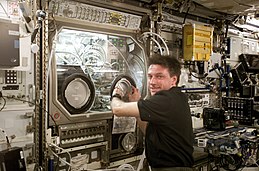
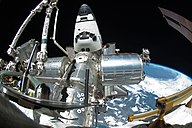







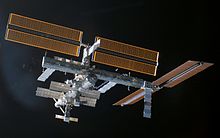


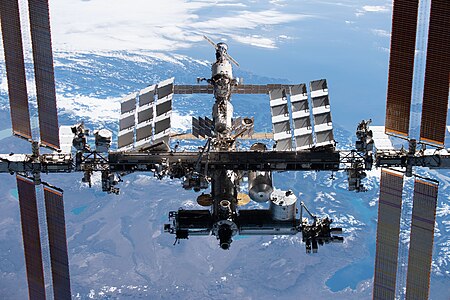







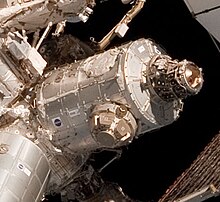


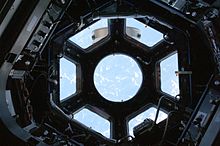




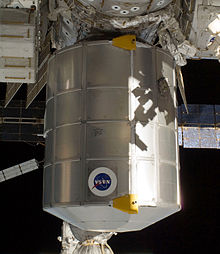



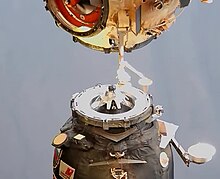
Comments
Post a Comment